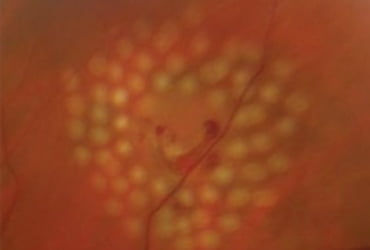Vitreous floaters, also known as 'flying flies,' are foreign substances like bugs or threads floating in front of the eyes. They can appear as one or multiple particles, and their locations tend to change along with gaze shifts. Vitreous floaters typically occur when the vitreous detaches and separates due to aging, resulting in opacities in the detached part. This causes cloudiness, and some of the incoming light to the eye is obstructed
Classification and Symptoms
Vitreous floaters can be classified into physiological and pathological floaters based on their causes.
Physiological floaters typically occur due to age-related changes in the vitreous. The vitreous is a transparent, jelly-like substance that fills the space inside of the eyes. As a person ages, the vitreous changes. Over time, it liquifies and contracts—a process that causes it to pull away and detach from the retina, which is called posterior vitreous detachment.
Pathological floaters are symptoms associated with various eye conditions, primarily arising from issues such as retinal detachment, vitreous hemorrhage, uveitis, and diabetic retinopathy.
As the retina detaches, the separated part becomes cloudy, casting shadows that may block some of the incoming light to the eye, resulting in a perception of seeing foreign substances in the field of vision.
Diagnosis
Vitreous floaters are a symptom that can be easily self-diagnosed, as they are visible even to the naked eye.
However, there are cases where they may not be observed through direct visual inspection.
As vitreous floaters can manifest as an initial symptom of retinal detachment or other conditions,
it is essential to undergo examinations extending to the periphery of the retina
Treatment
Vitreous floaters appearing as symptoms of other diseases can be improved by treating the underlying condition.
However, when vitreous floaters occur simply due to aging, there is no specific treatment.
Nevertheless, if vitreous floaters are severely impacting daily life, vitrectomy may be considered.
If other conditions are detected due to vitreous floaters, immediate treatment is required.
-

A retinal break was discovered and laser photocoagulation was performed
The One Seoul Eye Clinic has introduced the Ultra-widefield Retinal Imaging Device,
allowing for easy detection of abnormalities in the peripheral retina that may be overlooked,
and enabling immediate treatment upon discovery, contributing to enhanced stability in patient care
-
Weekdays
08:30 a.m. - 05:30 p.m -
Saturdays
08:30 a.m. - 01:30 p.m -
Lunchtime
01:00 p.m. - 02:00 p.m
8F and 9F Sinsa Square, 652 Gangnam-daero, Gangnam-gu, Seoul
o straight for 5 minutes (330m) on foot from
Exit 6 of Sinsa Station on Subway Line 3
